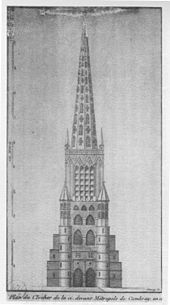Old Cambrai Cathedral
The old cathedral of Cambrai ( Ancienne cathédrale Notre-Dame de Cambrai ) was a mighty Gothic basilica with components from the Romanesque in Cambrai , northern France . It was the episcopal church of the Archdiocese of Cambrai until it was destroyed during the French Revolution . Today there are no remains of it. Its function was transferred to the former Saint-Sépulcre abbey in 1804 .
History and architecture
The first Marienkirche in the same place is attested for the year 525. In 580 the seat of the diocese of Arras was moved here. Several larger new buildings followed. The last previous building was destroyed by fire in 1148. After that, interrupted several times by fires and other events, the centuries-long building history of the Gothic cathedral began.
The oldest visible part was the Romanesque west building . The youngest part of the tower was the openwork late Gothic spire , which was not erected until 1360. Above all, it was to him that the cathedral owed its epithet "Wonder of the Netherlands " ( Merveille des Pays-Bas ).
The nave was built in early Gothic, the elongated high choir with chapel wreath in high Gothic forms with rich buttresses . The transept arms, which were also designed as fully developed choirs with chapels, were unusual.
From 1450 the cathedral housed the Byzantine icon of Mary Notre-Dame de Grâce , which was highly venerated and has been kept in the new cathedral since the beginning of the 19th century; there it was inserted into an altar structure, which is modeled on the west building of the old cathedral.
During the Renaissance , the Cambrai Cathedral was one of the most important European musical centers. The important composer Guillaume Du Fay († 1474) and u. a. Nicholas Grenon († 1456), Hayne van Ghizeghem († 1497), Jacob Obrecht († 1505), Loyset Compère († 1518), Laurent de Vos († 1580) and Philippe de Monte († 1603).
In the course of the French Revolution, the cathedral was opened for public worship in 1791 , but suffered damage the following year and was used as a granary from 1793. In 1796 it was acquired by a merchant who sold its stones as building material. After the turn of the century, plans began to conserve the remains. In 1809 the famous spire collapsed. In the following decade, the structure completely disappeared.
Web links
- recherche-fenelon.com (French)
- paroissesdecambrai.com (French)
Coordinates: 50 ° 10 ′ 33.8 ″ N , 3 ° 13 ′ 46.8 ″ E

